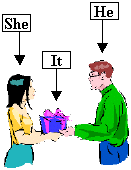Subjective Personal Pronouns - (Subject Pronouns)
Subjective Personal Pronouns subject or are those words that refer to the grammatical persons, ie, point to the subject performs the action.
He bought a new car. I bought a new car.
Like any pronoun, substitute or say the name of who performs the action and has been used before, such as in the following sentence:
Juan will travel to London. He will study English.
John will travel to London. I will study Inglés.
- I'm very strong / soy muy fuerte
- She sings and I play the guitar / Ella canta y yo toco la guitarra
- He has two ties / él tiene dos corbatas
She's very clever / ella es muy inteligente
Where's the remote control? 




| Subject Pronoun | Singular or Plural - Who? | Masculine or Feminine |
|---|---|---|
| I | Singular - first person | masculine or feminine |
| You | Singular - second person | masculine or feminine |
| He | Singular - third person | only masculine |
| She | Singular - third person | only feminine |
| It | Singular - third person | object / thing / animal |
| We | Plural - first person | masculine or feminine |
| You | Plural - second person | masculine or feminine |
| They | Plural - third person | masculine or feminine |
Object Pronouns:
They are used to indicate the subject performs the action and that must necessarily accompany the verb.
Definition:: It is a pronoun that is used as an object in the sentence.
Remember: A subjective or subject pronoun does the action and goes BEFORE the verb while object pronouns go AFTER the verb.
OBJECT PRONOUNS :
SINGULAR: —> Me (first person) You (2nd) Her / him / it (third person)
PLURAL —> Us (1st) You (2nd) Them (3rd)


| PRONOMBRES OBJETIVOS | SIGNIFICADO |
| ME | me, a mí |
| YOU | te, a tí, a usted |
| HIM | le, a él |
| HER | le, a ella |
| IT | le, a él, a ella, a ello (para animales o cosas) |
| US | nos, a nosotros, a nosotras |
| YOU | les, a ustedes |
| THEM | les, a ellos, a ellas |
John had forgiven me.
John me había perdonado. Objeto Directo
John me había perdonado. Objeto Directo
They designed it.
Ellos lo diseñaron. Objeto Directo
Ellos lo diseñaron. Objeto Directo
Lend me some money.
Préstame algo de dinero. Objeto Indirecto
Préstame algo de dinero. Objeto Indirecto
Susan showed me the exit.
Susan me mostró la salida. Objeto Indirecto
Susan me mostró la salida. Objeto Indirecto
Vale aclarar que si estos pronombres ocupan el lugar de objeto indirecto deben colocarse por delante del objeto directo en caso de que lo hubiere:
Sheyla made her a new dress.
Sheyla le hizo (a ella) un nuevo vestido.
Sheyla le hizo (a ella) un nuevo vestido.






















No hay comentarios:
Publicar un comentario